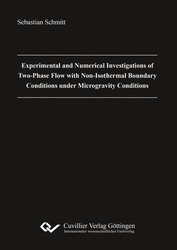| Departments | |
|---|---|
| Book Series (96) |
1379
|
| Nachhaltigkeit |
3
|
| Gesundheitswesen |
1
|
| Humanities |
2367
|
| Natural Sciences |
5407
|
| Engineering |
1793
|
| Engineering | 292 |
| Mechanical and process engineering | 862 |
| Electrical engineering | 686 |
| Mining and metallurgy | 30 |
| Architecture and civil engineering | 75 |
| Common |
98
|
|
Leitlinien Unfallchirurgie
5. Auflage bestellen |
|
Advanced Search
Experimental and Numerical Investigations of Two-Phase Flow with Non-Isothermal Boundary Conditions under Microgravity Conditions (English shop)
Sebastian Schmitt (Author)Preview
Table of Contents, PDF (53 KB)
Extract, PDF (180 KB)
Two-phase flow with a free surface, non-isothermal boundary conditions and heat and mass transfer over the free surface must be understood for a save operation of cryogenic upper stages with restart capability. This work is a foundational research carried out with numerical and experimental means.
A mathematical and numerical model were developed that allow to describe such systems under varying gravity levels. The reorientation of cryogenic parahydrogen upon a sudden gravity step reduction was investigated experimentally using the drop tower at ZARM, University of Bremen. Influencing the motion and final shape of the free surface could be realized with a precisely defined wall temperature gradient.
Heat and mass transfer over the free surface in a microgravity environment could be investigated numerically based on the experimental results of the SOURCE-II sounding rocket experiment. A transient simulation was carried out to study the coupled system between superheated container wall, subcooled liquid, free surface configuration and three-phase contact angle.
| ISBN-13 (Hard Copy) | 9783736994935 |
| ISBN-13 (eBook) | 9783736984936 |
| Final Book Format | A5 |
| Language | English |
| Page Number | 204 |
| Edition | 1. Aufl. |
| Publication Place | Göttingen |
| Place of Dissertation | Bremen |
| Publication Date | 2017-03-06 |
| General Categorization | Dissertation |
| Departments |
Manufacturing and production engineering
|
| Keywords | Microgravity, two-phase flow, heat transfer, mass transfer, CFD, CHT, experimental work, cryogenic fluids, free surface reorientation |








